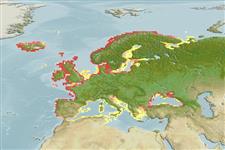Teleostei >
Salmoniformes (Salmons)
鮭形目 (Salmons) >
Salmonidae (Salmonids)
鮭科 (Salmonids) > Salmoninae
Etymology: Salmo: Latin, salmo, Plinius = salmon (Ref. 45335); trutta: trutta is a Latin name for trout (Ref. 10294).
More on author: Linnaeus.
Environment: milieu / climate zone / depth range / distribution range
生態學
海洋; 淡水; 半鹹淡水; 溯河洄游 (Ref. 51243); 深度上下限 0 - 28 m (Ref. 101587), usually 1 - 2 m (Ref. 101587). 溫帶; 18°C - 24°C (Ref. 12741); 71°N - 34°N, 25°W - 57°E
Europe and Asia: Atlantic, North, White and Baltic Sea basins, from Spain to Chosha Bay (Russia). Found in Iceland and northernmost rivers of Great Britain and Scandinavia. In Rhône drainage, native only to Lake Geneva basin, which it entered after last glaciation. Native to upper Danube and Volga drainages. Introduced widely. Several countries report adverse ecological impact after introduction.
歐洲與亞洲: 歐洲的在西北部海岸.(參考文獻 51442) 在美國 (參考文獻 5723) 與澳洲各處廣泛地引入。 引入後的一些國家報告不利的生態衝擊。
Length at first maturity / 大小 / 重量 / 年齡
Maturity: Lm 40.9, range 1 - 600 cm
Max length : 140 cm SL 雄魚/尚未辨別雌雄; (Ref. 682); common length : 72.0 cm TL 雄魚/尚未辨別雌雄; (Ref. 3397); 最大體重: 50.0 kg (Ref. 682); 最大年齡: 38 年 (Ref. 32682)
背棘 (總數) : 3 - 4; 背的軟條 (總數) : 10 - 15; 臀棘: 3 - 4; 臀鰭軟條: 9 - 14; 脊椎骨: 57 - 59. Fusiform body (Ref. 51442). Head little and pointed (Ref. 51442). Mouth large, extending mostly after the eye and has well developed teeth (Ref. 51442). Teeth on shaft of vomer numerous and strongly developed (Ref. 7251). Caudal fin with 18-19 rays (Ref. 2196). Caudal peduncle thick and rounded (Ref. 51442). Little scales (Ref. 51442). Body is grey-blue colored with numerous spots, also below the lateral line (Ref. 51442). Blackish colored on upper part of body, usually orange on sides, surrounded by pale halos. Adipose fin with red margin.
紡錘型身體.(參考文獻 51442) 頭部小與尖的.(參考文獻 51442) 嘴大的, 延伸在眼之後大部份而且有發展良好的齒.(參考文獻 51442) 牙齒在犛骨的軸很多與發育明顯的.(參考文獻 7251) 尾鰭有 18-19個鰭條。 (參考文獻 2196) 尾柄厚的而且圓的.(參考文獻 51442) 小的鱗片.(參考文獻 51442) 身體是灰色的-藍色的彩色有很多的斑點, 也在側線之下.(參考文獻 51442) 在身體的上半部上的黑色的色彩, 通常橘色的在側邊上, 被灰白的暈圈包圍了。 脂鰭有紅色的邊緣。
Found in streams, ponds, rivers and lakes (Ref. 5951). Individuals spend 1 to 5 years in fresh water and 6 months to 5 years in salt water (Ref. 51442). Juveniles mature in 3-4 years (Ref. 6885). Lacustrine populations undertake migration to tributaries and lake outlets to spawn, rarely spawning on stone, wave-washed lake shores. Spawns in rivers and streams with swift current, usually characterized by downward movement of water intro gravel (Ref. 59043). Spawning takes place normally more than one time (Ref. 51442). They prefer cold, well-oxygenated upland waters although their tolerance limits are lower than those of rainbow trout and favors large streams in the mountainous areas with adequate cover in the form of submerged rocks, undercut banks, and overhanging vegetation (Ref. 6465). Life history and spawning behavior is similar to the salmon Salmo salar (Ref. 51442). Each female produces about 10.000 eggs (Ref. 35388, Ref. 51442). Mainly diurnal (Ref. 682). Sea and lake trouts forage in pelagic and littoral habitats, while sea trouts mainly close to coast, not very far from estuary of natal river (Ref. 59043). Juveniles feed mainly on aquatic and terrestrial insects; adults on mollusks, crustaceans and small fish (Ref. 26523, Ref. 51442). Marketed fresh and smoked; eaten fried, broiled, boiled, cooked in microwave, and baked (Ref. 9988).
發現於溪流,池塘,河川與湖泊.。 (參考文獻 5951) 個體度過在淡水中的 1 到 5 年而且在鹹水中度過 6個月到 5 年。 (參考文獻 51442) 稚魚在 3-4 年中成熟。 (參考文獻 6885) 成魚在河 (參考文獻 30578) 中繁殖, 通常超過定時。 (參考文獻 51442) 他們偏愛寒冷,溶氧量高的丘陵地水域,雖然他們的包容限制是低於虹鱒的而且喜歡在多山的區域中的大溪流以足夠的覆蓋形成水下的岩石,堤岸下與上懸的植物.(參考文獻 6465) 生活歷史而且產卵行為是類似鮭魚 Salmo salar.(參考文獻 51442) 每個母魚生產大約 10.000個卵。 (參考文獻 35388, 參考文獻 51442) 主要日行性.(參考文獻 682) 稚魚主要捕食水生與陸棲的昆蟲; 成魚捕食軟體動物,甲殼動物與小魚。 (參考文獻 26523, 參考文獻 51442) 在市場上銷售燻製或新鮮.; 油炸後食用, 火烤,煮沸,在微波煮., 而且燒烤.。 (參考文獻 9988)
Life cycle and mating behavior
成熟度 | 繁殖 | 產卵場 | 卵 | 孕卵數 | 仔魚
Female covers the eggs by restirring the sand and fine gravel (Ref. 9696). After hatching at 12 mm, larval brown trout remain in the gravel for 2-3 weeks until they are about 25 mm long, when they emerge to begin feeding in the water column. Brown trout are territorial and begin establishing territories as juveniles. Juvenile trout from lake populations move from their natal inlets to lakes during the first 2 years of life (Ref. 6390).歐洲與亞洲: 歐洲的在西北部海岸.(參考文獻 51442) 在美國 (參考文獻 5723) 與澳洲各處廣泛地引入。 引入後的一些國家報告不利的生態衝擊。
Svetovidov, A.N., 1984. Salmonidae. p. 373-385. In P.J.P. Whitehead, M.-L. Bauchot, J.-C. Hureau, J. Nielsen and E. Tortonese (eds.) Fishes of the north-eastern Atlantic and the Mediterranean. UNESCO, Paris. vol. 1. (Ref. 4779)
IUCN 瀕危狀態 (Ref. 130435: Version 2024-2)
無危 (LC) ; Date assessed: 09 June 2022
人類使用
漁業: 商業性; 養殖: 商業性; 游釣魚種: 是的
工具
特別的報告
下載 XML
網路資源
Estimates based on models
Preferred temperature (Ref.
123201): 6.5 - 15.8, mean 10.1 °C (based on 918 cells).
Phylogenetic diversity index (Ref.
82804): PD
50 = 0.5000 [Uniqueness, from 0.5 = low to 2.0 = high].
Bayesian length-weight: a=0.00871 (0.00773 - 0.00982), b=3.03 (3.00 - 3.06), in cm total length, based on LWR estimates for this species (Ref.
93245).
營養階層 (Ref.
69278): 3.4 ±0.1 se; based on diet studies.
Generation time: 5.0 (2.8 - 9.2) years. Estimated as median ln(3)/K based on 14
growth studies.
回復力 (Ref.
120179): 中等的, 族群倍增時間最少 1.4 - 4.4年 (rm=0.9; K=0.09-0.8; tmax=8; Fec=1,000).
Prior r = 0.46, 95% CL = 0.30 - 0.68, Based on 1 data-limited stock assessment.
Fishing Vulnerability (Ref.
59153): High vulnerability (60 of 100).
Climate Vulnerability (Ref.
125649): Very high vulnerability (85 of 100).
Nutrients (Ref.
124155): Calcium = 33 [9, 88] mg/100g; Iron = 1.4 [0.5, 3.2] mg/100g; Protein = 19.5 [17.9, 21.2] %; Omega3 = 0.559 [0.234, 1.522] g/100g; Selenium = 19.1 [6.3, 57.8] μg/100g; VitaminA = 6.34 [1.15, 31.58] μg/100g; Zinc = 0.544 [0.363, 0.826] mg/100g (wet weight); based on
nutrient studies.
